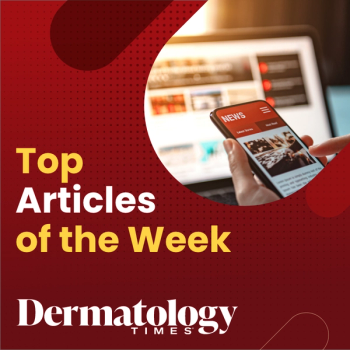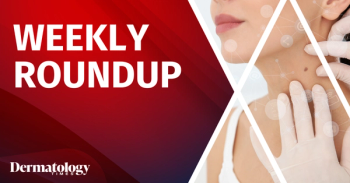
Journal Digest: May 14
Key Takeaways
- Switching to BRAF + MEK inhibitors improved recurrence-free survival in melanoma patients compared to PD-1 inhibitors, with no new safety concerns.
- Atypical fibroxanthoma showed low recurrence and metastasis rates, with lesions primarily in the head and neck region.
This review of the latest dermatologic studies includes insights into switching PD-1 to BRAF + MEK inhibition, clinical outcomes and prognosis in atypical fibroxanthoma, and more.
Journal of the European Academy of Dermatology and Venereology: Switching PD-1 to BRAF + MEK inhibition improves recurrence-free survival in patients receiving a second course of adjuvant melanoma therapy
A recent multicenter retrospective study evaluated outcomes of a second course of adjuvant therapy in patients with stage III–IV melanoma following disease recurrence and surgery. Researchers assessed 66 patients treated with either PD-1 inhibitors (nivolumab or pembrolizumab) or BRAF + MEK inhibitors (dabrafenib plus trametinib) between 2017 and 2021. Twelve-month recurrence-free survival (RFS2) favored BRAF + MEK therapy over PD-1 blockade (90.6% vs. 70.6%, p=0.030), a trend sustained at 24 months (71.9% vs. 52.9%). Overall survival remained high (≥93.8%) at 24 months across both groups, and no new safety concerns were identified.1
International Journal of Dermatology: Clinical Outcomes and Prognosis in Atypical Fibroxanthoma: A Systematic Review and Meta-Analysis
A recent systematic review and meta-analysis investigated recurrence rates, prognostic factors, and management strategies for atypical fibroxanthoma (AFX), a rare dermal spindle-cell tumor. Researchers analyzed 8 studies published between 2002 and 2024, involving 1,366 patients, primarily elderly males (78.9%) with an average age of 76.9 years. Lesions were most commonly located in the head and neck region (89%) and averaged 14.9 mm in diameter. The pooled local recurrence rate was found to be 4.73% (95% CI: 2.24–9.73%), with a metastasis rate of 0.59% and no disease-specific mortality.2
Contact Dermatitis: The Effect of Alcohol-Based Virucidal Hand Sanitizers on Skin Barrier Function—A Randomised Experimental Study
A recent study evaluated the impact of four commercially available alcohol-based virucidal hand rubs (ABVHRs) on skin function. The rubs, labeled ABVHR-A through ABVHR-D, contained varying concentrations of ethanol and 1-propanol, with ABVHR-C and ABVHR-D also including phosphoric acid. Using irritation tests and bioengineering methods, researchers assessed the effects on 48 healthy volunteers. Results indicated that while ABVHRs were generally well tolerated, they caused significant changes in skin hydration and barrier function, particularly with ABVHR-D, which increased transepidermal water loss (TEWL). Compared to water, ABVHR-A and ABVHR-D notably increased TEWL, but overall, ABVHRs were less irritating than pure ethanol and isopropanol.3
JEADV Clinical Practice: The Association of Psoriasis With Sleep Disorders in a Diverse National Cohort
A recent study explored the relationship between psoriasis severity and the risk of developing sleep disorders, with a focus on how these associations vary across racial/ethnic groups. Using health records from 7,743 adults with psoriasis from the NIH’s All of Us database, researchers conducted multivariable regression analyses, adjusting for sociodemographic variables and comorbidities. The results showed that both mild and moderate to severe psoriasis were significantly linked to an increased risk of sleep disorders, including restless leg syndrome, insomnia, and obstructive sleep apnea.4
Photochemistry and Photobiology: Erythemal UV radiation exposure during jogging
A recent study investigated the UVR exposure during jogging, focusing on different body sites and solar elevations. Researchers used miniature UVR meters to measure exposure on 7 body sites, including the shoulders, calves, and forearms, during jogging in cloud-free conditions with solar elevations ranging from 20° to 60°. The study found that the shoulders received the highest UVR exposure, up to 80% of ambient levels, with peaks exceeding 100%. Other areas like the calves and thighs had significantly lower exposure. The results highlighted that UVR exposure is influenced by the direction a jogger faces and the time of day.5
References
- Schumann K, Klespe KC, Mauch C, et al. Switching PD-1 to BRAF + MEK inhibition improves recurrence-free survival in patients receiving a second course of adjuvant melanoma therapy. J Eur Acad Dermatol Venereol. Published online May 7, 2025.
doi:10.1111/jdv.20708 - von Dannecker R, de Oliveira LML, Lapenda I, et al. Clinical outcomes and prognosis in atypical fibroxanthoma: a systematic review and meta-analysis. Int J Dermatol. Published online May 11, 2025.
doi:10.1111/ijd.17841 - Gina M, Ofenloch R, Schwebke I, et al. The effect of alcohol-based virucidal hand sanitizers on skin barrier function—a randomised experimental study. Contact Dermatitis. Published online May 12, 2025.
doi:10.1111/cod.14808 - Diaz MJ, Haq Z, Tran JT, et al. The association of psoriasis with sleep disorders in a diverse national cohort. JEADV Clin Pract. Published online May 13, 2025.
doi:10.1002/jvc2.70022 - Schmalwieser AW, Danhel H, Schmalwieser SS, et al. Erythemal UV radiation exposure during jogging. Photochem Photobiol. Published online May 6, 2025.
doi:10.1111/php.14114
What new studies have you been involved with or authored? Share with us by emailing
Newsletter
Like what you’re reading? Subscribe to Dermatology Times for weekly updates on therapies, innovations, and real-world practice tips.


















